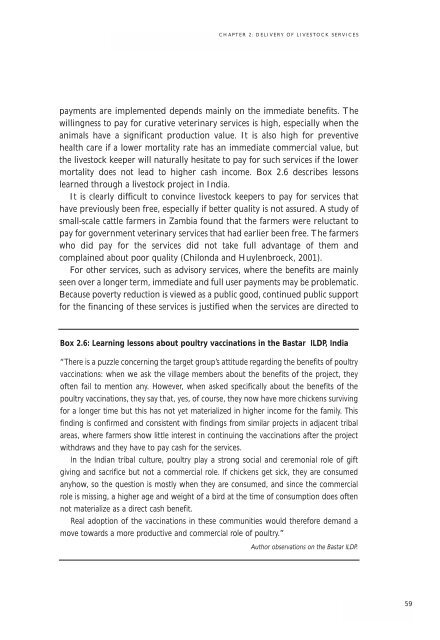Livestock Services and the Poor: A global initiative - IFAD
Livestock Services and the Poor: A global initiative - IFAD
Livestock Services and the Poor: A global initiative - IFAD
You also want an ePaper? Increase the reach of your titles
YUMPU automatically turns print PDFs into web optimized ePapers that Google loves.
CHAPTER 2: DELIVERY OF LIVESTOCK SERVICES<br />
payments are implemented depends mainly on <strong>the</strong> immediate benefits. The<br />
willingness to pay for curative veterinary services is high, especially when <strong>the</strong><br />
animals have a significant production value. It is also high for preventive<br />
health care if a lower mortality rate has an immediate commercial value, but<br />
<strong>the</strong> livestock keeper will naturally hesitate to pay for such services if <strong>the</strong> lower<br />
mortality does not lead to higher cash income. Box 2.6 describes lessons<br />
learned through a livestock project in India.<br />
It is clearly difficult to convince livestock keepers to pay for services that<br />
have previously been free, especially if better quality is not assured. A study of<br />
small-scale cattle farmers in Zambia found that <strong>the</strong> farmers were reluctant to<br />
pay for government veterinary services that had earlier been free. The farmers<br />
who did pay for <strong>the</strong> services did not take full advantage of <strong>the</strong>m <strong>and</strong><br />
complained about poor quality (Chilonda <strong>and</strong> Huylenbroeck, 2001).<br />
For o<strong>the</strong>r services, such as advisory services, where <strong>the</strong> benefits are mainly<br />
seen over a longer term, immediate <strong>and</strong> full user payments may be problematic.<br />
Because poverty reduction is viewed as a public good, continued public support<br />
for <strong>the</strong> financing of <strong>the</strong>se services is justified when <strong>the</strong> services are directed to<br />
Box 2.6: Learning lessons about poultry vaccinations in <strong>the</strong> Bastar ILDP, India<br />
“There is a puzzle concerning <strong>the</strong> target group’s attitude regarding <strong>the</strong> benefits of poultry<br />
vaccinations: when we ask <strong>the</strong> village members about <strong>the</strong> benefits of <strong>the</strong> project, <strong>the</strong>y<br />
often fail to mention any. However, when asked specifically about <strong>the</strong> benefits of <strong>the</strong><br />
poultry vaccinations, <strong>the</strong>y say that, yes, of course, <strong>the</strong>y now have more chickens surviving<br />
for a longer time but this has not yet materialized in higher income for <strong>the</strong> family. This<br />
finding is confirmed <strong>and</strong> consistent with findings from similar projects in adjacent tribal<br />
areas, where farmers show little interest in continuing <strong>the</strong> vaccinations after <strong>the</strong> project<br />
withdraws <strong>and</strong> <strong>the</strong>y have to pay cash for <strong>the</strong> services.<br />
In <strong>the</strong> Indian tribal culture, poultry play a strong social <strong>and</strong> ceremonial role of gift<br />
giving <strong>and</strong> sacrifice but not a commercial role. If chickens get sick, <strong>the</strong>y are consumed<br />
anyhow, so <strong>the</strong> question is mostly when <strong>the</strong>y are consumed, <strong>and</strong> since <strong>the</strong> commercial<br />
role is missing, a higher age <strong>and</strong> weight of a bird at <strong>the</strong> time of consumption does often<br />
not materialize as a direct cash benefit.<br />
Real adoption of <strong>the</strong> vaccinations in <strong>the</strong>se communities would <strong>the</strong>refore dem<strong>and</strong> a<br />
move towards a more productive <strong>and</strong> commercial role of poultry.”<br />
Author observations on <strong>the</strong> Bastar ILDP.<br />
59

















